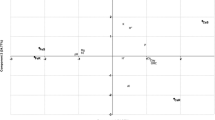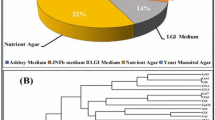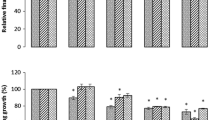Abstract
Iron (Fe) is an essential element for plant growth and development. Some plant growth-promoting rhizobacteria can increase Fe uptake by plants through reduction of Fe(III) to Fe(II) at the root surface. The aim of this work was to identify novel bacterial strains with high Fe(III) reduction ability and to evaluate their role in plant Fe uptake. Four bacterial strains (UMCV1 to UMCV4) showing dissimilatory Fe-reducing activity were isolated from the rhizosphere of bean and maize plants and further identified by 16S rDNA amplification and sequence analysis. From these analyses, UMCV1 and UMCV2 isolates were identified as Bacillus megaterium and Arthrobacter spp., respectively, whereas UMCV3 and UMCV4 were identified as Stenotrophomonas maltophilia. All four isolates showed Fe reduction in a nonflooded soil and when associated with roots of bean plants grown in alkaline soil or in mineral medium. In addition, the bacterial isolates were able to stimulate plant growth in vitro and on a broad level, plants grown in inoculated soil were generally bigger and with higher Fe content than those grown in sterilized soil. These results indicate that bacterial species isolated from the rhizosphere of bean and maize plants contribute significantly to Fe uptake by plants likely through increased Fe(III) reduction in the rhizosphere.





Similar content being viewed by others
References
Altschul SF, Gish W, Miller W, Myers EW, Lipman DJ (1990) Basic local alignment search tool. J Mol Biol 215:403–410
Arkhipova TN, Veselov SU, Melentiev AI, Martynenko EV, Kudoyarova GR (2005) Ability of bacterium Bacillus subtilis to produce cytokinins and to influence the growth and endogenous hormone content of lettuce plants. Plant Soil 272:201–209
Bowen GD, Rovira AD (1999) The rhizosphere and its management to improve plant growth. Adv Agron 66:1–102
Costa R, Götz M, Mrotzek N, Lottmann J, Berg G, Smalla K (2006) Effects of site and plant species on rhizosphere community structure as revealed by molecular analysis of microbial guilds. FEMS Microbiol Ecol 56:236–249
Ding Y, Wang J, Liu Y, Chen S (2005) Isolation and identification of nitrogen-fixing bacilli from plant rhizospheres in Beijing region. J Appl Microbiol 99:1271–1281
Garbeva P, Overbeek LS, Vuurde JW, Elsas JD (2001) Analysis of endophytic bacterial communities of potato by plating and denaturing gradient gel electrophoresis (DGGE) of 16S rDNA based PCR fragments. Microb Ecol 41:369–383
Ivanov V, Stabnikov V, Zhuang WQ, Tay JH, Tay STL (2005) Phosphate removal from the returned liquor of municipal wastewater treatment plant using iron-reducing bacteria. J Appl Microb 98:1152–1161
Jaeger CH, Lindow SE, Miller W, Clark E, Firestone MK (1999) Mapping of sugar and amino acid availability in soil around roots with bacterial sensors of sucrose and tryptophan. Appl Environ Microbiol 65:2685–2690
Karlin KD (1993) Metalloenzymes, structural motifs and inorganic models. Science 261:701–708
King GM, Garey MA (1999) Ferric iron reduction by bacteria associated with the roots of freshwater and marine macrophytes. Appl Environ Microbiol 65:4393–4398
Kosegarten H, Wilson GH, Esch A (1988) The effect of nitrate nutrition on iron chlorosis and leaf growth in sunflower (Helianthus annuus L.). Eur J Agron 8:283–292
Liu X, Zhao H, Chen S (2006) Colonization of maize and rice plants by strain Bacillus megaterium C4. Curr Microbiol 52:186–190
Loneragan DJ, Jenter HL, Coates J, Phillips EJ, Schmidt TM, Lovley DR (1996) Phylogenetic analysis of dissimilatory Fe(III)-reducing bacteria. J Bacteriol 178:2402–2408
López-Bucio J, Nieto Jacobo MF, Ramírez Rodríguez V, Herrera Estrella L (2000) Organic acid metabolism in plants: from adaptive physiology to transgenic varieties for cultivation in extreme soils. Plant Sci 160:1–13
Lovley DR (1991) Dissimilatory Fe(II) and Mn(IV) reduction. Microbiol Rev 55:259–287
Lovley DR (1993) Dissimilatory metal reduction. Annu Rev Microbiol 47:236–290
Lovley DR (1995) Microbial reduction of iron, manganese and other metals. Adv Agron 4:175–231
Lovley DR, Phillips JP (1987) Rapid assay for microbially reducible ferric iron in aquatic sediments. Appl Environ Microbiol 53:1536–1540
Lovley DR, Phillips JP (1989) Requirement for a microbial consortium to completely oxidize glucose in Fe(III)-reducing sediments. Appl Environ Microbiol 55:3234–3236
Lynch JM, Whipps JM (1990) Substrate flow in the rhizosphere. Plant Soil 129:1–10
Masalha J, Kosegarten H, Elmaci O, Mengel K (2000) The central role of microbial activity for iron acquisition in maize and sunflower. Biol Fertil Soils 30:433–439
Mengel K, Kirkby EA (2001) Principles of plant nutrition. Kluwer Academic Publishers, Dordrecht , 564 pp
Nielsen JL, Juretschko S, Wagner M, Nielsen PH (2001) Abundance and phylogenetic affiliation of iron reducers in activated sludge as assessed by fluorescence in situ hybridization and microautoradiography. Appl Environ Microbiol 68:4629–4636
Ottow JCG, Glathe H (1971) Isolation and identification of iron-reducing bacteria from gley soils. Soil Biol Biochem 3:43–55
Persello-Cartieaux F, David P, Sarrobert C, Thibaud MC, Robaglia C, Nussaume L (2001) Utilization of mutants to analyze the interaction between Arabidopsis thaliana and its naturally root-associated Pseudomonas. Planta 212:190–198
Persello-Cartieaux F, Nussaume L, Robaglia C (2003) Tales from the underground: molecular plant–rhizobacteria interactions. Plant Cell Environ 26:189–199
Picard C, Di Cello F, Ventura M, Fani R, Guckert A (2000) Frequency and biodiversity of 2,4-diacetylphloroglucinol-producing bacteria isolated from the maize rhizosphere at different stages of plant growth. Appl Environ Microbiol 66:948–955
Ramírez-Rodríguez V, López Bucio J, Herrera Estrella L (2005) Adaptive responses in plants to non optimal soil pH. In: Jenks MA, Hasegawa PM (eds) Plant abiotic stress. Blackwell Plant Science Series, Oxford, UK, pp 145–170
Römheld V (1987) Different strategies for iron acquisition in higher plants. Physiol Plant 70:231–234
Rroco E, Kosegarten H, Harizaj F, Imani J, Mengel K (2003) The importance of soil microbial activity for the supply of iron to sorghum and rape. Eur J Agron 19:487–493
Schikora A, Schmidt W (2001) Iron stress-induced changes in root epidermal cell fate are regulated independently from physiological responses to low iron availability. Plant Physiol 125:1679–1687
Schmidt W (1994) Effects of various inhibitors on in vivo iron reduction by Plantago lanceolata L. roots. Plant Soil 165:207–212
Schmidt W (1999) Mechanisms and regulation of reduction based iron uptake in plants. New Phytol 141:1–26
Smalla K, Wieland G, Buchner A, Zock A, Parzy J, Kaiser S, Roskot N, Heuer H, Berg G (2001) Bulk and rhizosphere soil bacterial communities studied by denaturing gradient gel electrophoresis, plant-dependent enrichment and seasonal shifts revealed. Appl Environ Microbiol 67:4742–4751
Stafford WHL, Baker GC, Brown SA, Burton SG, Cowan DA (2005) Bacterial diversity in the rhizosphere of Proteaceae species. Environ Microbiol 7:1755–1768
Stemmler SJ, Loyaux-Lawniczak S, Berthelin J (2004) Effect of soil water content on the microbial reduction of iron oxides. C R Geosci 336:1171–1179
Sturz AV, Matheson BG, Arsenault W, Kimpinski J, Christie BR (2001) Weeds as a source of plant growth promoting rhizobacteria in agricultural soils. Can J Microbiol 47:1013–1024
Suckstorff I, Berg G (2003) Evidence for dose-dependent effects on plant growth by Stenotrophomonas strains from different origins. J Appl Microbiol 95:656–663
Susin S, Abadia A, Gonzalez-Reyes JA, Lucena JJ, Abadia J (1996) The pH requirement for in vivo activity of the iron-deficiency-induced “turbo” ferric chelate reductase (a comparison of the iron-deficiency-induced iron reductase activities of intact plants and isolated plasma membrane fractions in sugar beet). Plant Physiol 110:111–123
Valencia-Cantero E, Martínez-Romero E, Peña-Cabriales JJ (2003) The corrosion effects of sulfate- and ferric-reducing bacterial consortia on steel. Geomicrobiol J 20:157–170
Weisburg W, Barns SM, Pelletier DA, Lane DJ (1991) 16S ribosomal DNA amplification for phylogenetic study. J Bacteriol 173:697–703
Weiss JV, Emerson D, Backer SM, Megonical JP (2003) Enumeration of Fe(II)-oxidizing and Fe(III)-reducing bacteria in the root zone of wetland plants, implications for a rhizosphere iron cycle. Biogeochemistry 64:77–96
Weiss JV, Emerson D, Megonigal JP (2004) Geochemical control of microbial Fe(III) reduction potential in wetlands, comparison of the rhizosphere to non-rhizosphere soil. FEMS Microbiol Ecol 48:89–100
Weiss JV, Emerson D, Megonigal JP (2005) Rhizosphere iron(III) deposition and reduction in a Juncus effusus L.-dominated wetland. Soil Sci Soc Am J 69:1861–1870
Wu H, Li L, Yuan Y, Cheng X, Ling AQ (2005) Molecular and biochemical characterization of the Fe (III) chelate reductase gene family in Arabidopsis thaliana. Plant Cell Physiol 46:1505–1514
Acknowledgments
This work was supported by Grants from the Coordinación de la Investigación Científica (UMSNH, CIC 2.2) and Consejo Nacional de Ciencia y Tecnología (42899) to EVC. EHC was supported by scholarships from CONACyT and UMSNH.
Author information
Authors and Affiliations
Corresponding author
Rights and permissions
About this article
Cite this article
Valencia-Cantero, E., Hernández-Calderón, E., Velázquez-Becerra, C. et al. Role of dissimilatory fermentative iron-reducing bacteria in Fe uptake by common bean (Phaseolus vulgaris L.) plants grown in alkaline soil. Plant Soil 291, 263–273 (2007). https://doi.org/10.1007/s11104-007-9191-y
Received:
Accepted:
Published:
Issue Date:
DOI: https://doi.org/10.1007/s11104-007-9191-y




